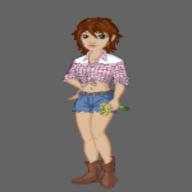各位人兄,小弟有一份功課,望各位相助。
幫助方法:提供和雞蛋的成份和結構有關的資料。(英文/中英對照)
雞蛋的資料(10分!!!!!!!!!!!!!!!!!!!!!!)
2007-03-15 3:52 am
回答 (3)
2007-03-18 2:21 am
✔ 最佳答案
圖片參考:http://www.exploratorium.edu/cooking/eggs/images/eggcrosssection.gif
SHELL
Bumpy and grainy in texture, an eggshell is covered with as many as 17,000 tiny pores. Eggshell is made almost entirely of calcium carbonate (CaCO3) crystals. It is a semipermeable membrane, which means that air and moisture can pass through its pores. The shell also has a thin outermost coating called the bloom or cuticle that helps keep out bacteria and dust.
圖片參考:http://www.exploratorium.edu/cooking/eggs/images/line_490.gif
INNER AND OUTER MEMBRANES
Lying between the eggshell and egg white, these two transparent protein membranes provide efficient defense against bacterial invasion. If you give these layers a tug, you’ll find they’re surprisingly strong. They’re made partly of keratin, a protein that’s also in human hair.
圖片參考:http://www.exploratorium.edu/cooking/eggs/images/line_490.gif
AIR CELL
An air space forms when the contents of the egg cool and contract after the egg is laid. The air cell usually rests between the outer and inner membranes at the egg’s larger end, and it accounts for the crater you often see at the end of a hard-cooked egg. The air cell grows larger as an egg ages.
圖片參考:http://www.exploratorium.edu/cooking/eggs/images/line_490.gif
ALBUMEN
The egg white is known as the albumen, which comes from albus, the Latin word for “white.” Four alternating layers of thick and thin albumen contain approximately 40 different proteins, the main components of the egg white in addition to water.
圖片參考:http://www.exploratorium.edu/cooking/eggs/images/line_490.gif
CHALAZAE
Opaque ropes of egg white, the chalazae hold the yolk in the center of the egg. Like little anchors, they attach the yolk’s casing to the membrane lining the eggshell. The more prominent they are, the fresher the egg.
圖片參考:http://www.exploratorium.edu/cooking/eggs/images/line_490.gif
VITELLINE
MEMBRANE
The clear casing that encloses the yolk.
圖片參考:http://www.exploratorium.edu/cooking/eggs/images/line_490.gif
YOLK
The yolk contains less water and more protein than the white, some fat, and most of the vitamins and minerals of the egg. These include iron, vitamin A, vitamin D, phosphorus, calcium, thiamine, and riboflavin. The yolk is also a source of lecithin, an effective emulsifier. Yolk color ranges from just a hint of yellow to a magnificent deep orange, according to the feed and breed of the hen.
http://www.exploratorium.edu/cooking/eggs/eggcomposition.html
中文: http://zh.wikipedia.org/wiki/%E9%9B%9E%E8%9B%8B
不是完全同英文一樣,但應有助理解
Nutritional values of the egg - 英文
太長post 唔到喇, 去以下網址睇:
http://www.nutritionandeggs.co.uk/eggs_nutrition/nutrition1.html
~:)
2007-03-15 4:02 am
雞蛋所含的營養物質
所有的禽蛋類(包括雞蛋)都屬於酸性食物。一個雞蛋去掉殼和"內膜"(中藥名稱叫做"鳳凰衣")之後,在外面裹著一層厚厚的雞子白、雞蛋白或稱雞蛋清,雞子白是由三層成份組成的,其外層及內層都比較稀薄,而中層因含有0.3%黏蛋白(mucin,佔雞子白總重量的65%),故而較為黏稠。每100克中約含有蛋白質10克,脂肪0.1克,碳水化合物1.3克(詳見表1)。按水份和固形物所佔比重,則含水份88%,固形物12%,固形物中大約90%是蛋白質,內有:卵白蛋白(ovalbumin)佔75%,卵類黏蛋白(ovomucoid)佔15%,卵黏蛋白(ovomucin)佔7%,伴白蛋白(conalbumin)佔3%。
其中,卵白蛋白是一種含磷蛋白質,含有1.7%的甘露糖(mannose),卵類黏蛋白中所含醣類是一種"混合醣類",大約佔9.2%,即由三份甘露糖與一份半乳糖(galactose)組成,卵黏蛋白內亦含14.9%的混合醣類,其中甘露糖與半乳糖含量相等,伴白蛋白內含有2.8%的混合醣類,其中甘露糖與半乳糖含量相等,伴白蛋白內含有2.8%的混合醣類,其中甘露糖三份、半乳糖一份。全雞子白還含有大約0.4%的游離葡萄糖。
卵類黏蛋白也是一個混合物,其中含有溶菌(lysozyme)、卵蛋白抑制物(ovoinhibitor)、卵糖蛋白(ovoglycoprotein)、卵黃素蛋白(ovoflavoprotein)以及卵類黏蛋白等。
雞蛋白含脂類甚少,但也有微量的脂肪,如痕跡量的卵磷脂(lecithin)、膽固醇(cholesterol)以及脂溶性色素-脂色素(lutein)等。雞子白的蛋白質在營養上是優良的,因為它含所有的"必需胺基酸",即白胺酸(按100克計含1175毫克,下同)、異白胺酸(639)、甲硫胺酸(433)、離胺基酸(715)、色胺基酸(204)、苯丙胺酸(715)、纈胺酸(866)、蘇胺酸(664)等。
裡面包著的是一個雞蛋黃,每100克中含有水份53.3克,蛋白質13.6克,脂類30克,碳水化合物1.3克,其內所含的蛋白質有卵黃磷蛋白(vitellin)、卵黃球蛋白(livetin),其含率比約為3.6:1;另外,還含有至少五種唾液酸糖蛋白(sialoglycoprotein)。
雞蛋黃含有大量的脂肪性物質,其中約10%是磷脂(phospolipids),而磷脂中又以卵磷脂為主;上述"卵黃磷蛋白",在雞子黃中就是與卵磷脂結合而存在的。脂肪性物質中的脂肪酸,主要是油酸(oleinic acid,佔脂肪酸總量的46.7%)、亞油酸(linoleic acid,佔19%)、亞麻酸(linolenic acid,佔2.9%)、飽和酸(saturated acid,佔31.4%)。此外,還含有脂色素及其多種異構物,游離的及化合的葡萄糖(約佔0.3%),也含有少量的胡蘿蔔素(不超過0.02毫克/100克),儘管整個雞蛋中(連同蛋清及蛋黃)每100克含有膽固醇450~680毫克,而在100客克"蛋黃"卻含有1705~2000毫克膽固醇。
"雞蛋殼"的主要成份是碳酸鈣(calcium carbonate),含有91.96~95.76%,此外尚含有碳酸鎂(magnesium carbonate)、磷酸鈣(calciun phosphate)及膠質(colloid)等;有機物的含量約3.55~6.45%,蛋殼中的"色素"有好幾種,主要為(porphyrin)等。
一個雞蛋的基本營養素
我打聽了一下營養專家們,他說說:"基本上都是按照「每100公克」雞蛋計算的,很少按「個」計算;就是按「個」,每一個也不超過40克或45克,外國的營養學家們也都是按此一標準衡量的。"我性格好奇,於是從外地帶回不少雞蛋來,實際砰一砰心中也就有底細了。不測還好,一測使我嚇一跳,最低的每個雞蛋重約34.9克、最高的竟有78.6克,後者特別是"蛋用型"雞(一般來說,雞分蛋用型、肉用型、蛋肉兼用型、觀賞用等類型;蛋用型就巢性退化)。一公斤雞蛋小的只約18~20個,而大的卻約12~14個,就拿最大的78.6克來說,去了蛋殼和內膜8.3克之後,還剩下蛋白達49.1克、蛋黃21.2克(兩者合計為70.3克),這那裡有按"個"說"不超過40或45克"的呢?看來絕非如此!
一個雞蛋可供維他命的數量
維他命是維持人體正常功能的一類低分子有機化合物,它們在體內不能合成或合成量不足,雖然需要量很小,但必須由食物供給。維他命可分為脂溶性及水溶性兩大類,前者有維他命A、D、E、K(雞蛋中除了維他命K尚未查明之外,其它都有)。脂溶性維他命不溶於水,而溶於脂肪,在雞蛋中與脂類共同存在,在腸道吸收時也與脂類吸收密切相關;當患脂類吸收不良時(如患膽道梗阻或長期腹瀉),對它們的吸收大為減少。水溶性維他命包括B族維他命及維他命C(可惜的是雞蛋中沒有維他命C),B族維他命倒是不少,而且它們可以構成種種"輔酵素"(coenzyme)。例如,維他命B1又叫硫胺素(thiamine),它可構成焦磷酸硫胺素(thiamine pyrophosphate);維他命B2又叫核黃素(lactoflavin或riboflavin),它可構成黃素單核酸(flavin mononucleotide)和黃素腺嘌呤二核酸(flavin adenine dinucleotide);維他命B6又叫哆辛(pyridoxine),它可構成磷酸哆醛(pyridoxal phosphate);維他命B12又叫氰鈷胺(cyanocobalamin),它可構成鈷胺素輔(cobamide coenzyme)等(詳見表5)。
雞蛋不論是炒還是煮,都損失不了多少維他命。設若一個生雞蛋原來含硫胺素0.10毫克、核黃素0.27毫克、尼克酸0.10毫克,經過炒(指去殼、打勻、加鹽適量,用油炒1~1.5分鐘)之後,依然保留著0.08毫克、0.26毫克與0.1毫克,保存率分別達到87%、98%與100%;經過煮(將整個雞蛋放在水中,用大火煮沸10分鐘)之後,與原來的含量差別有限,保留著0.09毫克、0.27毫克與0.1毫克,保存率達到93%、97%與96%。
雞蛋與患病的關係
一般地說,「雞蛋」對於我們人類的營養是有很大幫助的,它能供給我們所需的蛋白質、金屬元素和維他命等,所產生的熱量去幹各種工作;如一個重量為50克的雞蛋,產生熱能318千焦,用它可以走路32分鐘、騎車23分鐘或者跑步15分鐘等等。如果說,一旦患了病,就得增加營養,這是必然的,於是就產生了這樣一個想法:似乎「雞蛋吃得越多越好」;其實,那也不盡然。
譬如說,每100克蛋黃中含膽固醇將近2,000毫克,蛋白中也含650毫克左右,嚴重高脂血症(hyperlipemia)患者顯然要適當吃膽固醇較低的東西,至多食用一個雞蛋,或者只吃蛋白不吃蛋黃,再如,肝功能衰褐和肝昏迷(hepatic coma;又名肝性腦病,hepatic encephalopathy)患者,絕對不能吃雞蛋,因為每100克蛋清中可以產胺0.744克,蛋黃更加厲害,每100克中可以產胺2.560克,兩者均可加重病情(比如一個重約55克的雞蛋,可以產胺量大致為:組織胺酸169毫克、甘胺酸249毫克、蘇胺酸350毫克、離胺基酸450毫克、絲胺酸591毫克等,而肝昏迷患者正是由於"胺之代謝異常"所引起的)。患有慢性腎功能衰竭、糖尿病性腎功能不全以及尿毒症病人,應食"高生物價低蛋白飲食",因而每天最多只能吃一個雞蛋或蛋白40克。若遇醫師告知病人需要要求"特殊飲食"(如低鈣飲食、低磷飲食、低蛋白無肌酐飲食、鈣磷鈉固定飲食等等)時,最多也只能吃一個或兩個雞蛋,而非「雞蛋吃得越多越好」。
"痛風"是一種與遺傳有關的嘌呤(purine)代謝紊亂所致的疾病,為避免攝人外源性嘌呤類較高的食物進入體內,如瘦肉、魚類和禽類每100克食物中含嘌呤100~1,000毫克,此外乾豆類、扁豆、菠菜、蘆、蘑菇、龍鬚菜等每100克中也有90~100毫克,而一個雞蛋只含0.4毫克,因此可多吃一些。
不吃雞蛋可以用肉等來替補,比如一個重約50克左右的雞蛋,可以用瘦肉9克及脂肪5克來替代;或者用肥瘦牛、羊、豬肉25克。瘦香腸20克、豆腐絲50克、南豆腐125克(北豆腐100克)等等來替換。
所有的禽蛋類(包括雞蛋)都屬於酸性食物。一個雞蛋去掉殼和"內膜"(中藥名稱叫做"鳳凰衣")之後,在外面裹著一層厚厚的雞子白、雞蛋白或稱雞蛋清,雞子白是由三層成份組成的,其外層及內層都比較稀薄,而中層因含有0.3%黏蛋白(mucin,佔雞子白總重量的65%),故而較為黏稠。每100克中約含有蛋白質10克,脂肪0.1克,碳水化合物1.3克(詳見表1)。按水份和固形物所佔比重,則含水份88%,固形物12%,固形物中大約90%是蛋白質,內有:卵白蛋白(ovalbumin)佔75%,卵類黏蛋白(ovomucoid)佔15%,卵黏蛋白(ovomucin)佔7%,伴白蛋白(conalbumin)佔3%。
其中,卵白蛋白是一種含磷蛋白質,含有1.7%的甘露糖(mannose),卵類黏蛋白中所含醣類是一種"混合醣類",大約佔9.2%,即由三份甘露糖與一份半乳糖(galactose)組成,卵黏蛋白內亦含14.9%的混合醣類,其中甘露糖與半乳糖含量相等,伴白蛋白內含有2.8%的混合醣類,其中甘露糖與半乳糖含量相等,伴白蛋白內含有2.8%的混合醣類,其中甘露糖三份、半乳糖一份。全雞子白還含有大約0.4%的游離葡萄糖。
卵類黏蛋白也是一個混合物,其中含有溶菌(lysozyme)、卵蛋白抑制物(ovoinhibitor)、卵糖蛋白(ovoglycoprotein)、卵黃素蛋白(ovoflavoprotein)以及卵類黏蛋白等。
雞蛋白含脂類甚少,但也有微量的脂肪,如痕跡量的卵磷脂(lecithin)、膽固醇(cholesterol)以及脂溶性色素-脂色素(lutein)等。雞子白的蛋白質在營養上是優良的,因為它含所有的"必需胺基酸",即白胺酸(按100克計含1175毫克,下同)、異白胺酸(639)、甲硫胺酸(433)、離胺基酸(715)、色胺基酸(204)、苯丙胺酸(715)、纈胺酸(866)、蘇胺酸(664)等。
裡面包著的是一個雞蛋黃,每100克中含有水份53.3克,蛋白質13.6克,脂類30克,碳水化合物1.3克,其內所含的蛋白質有卵黃磷蛋白(vitellin)、卵黃球蛋白(livetin),其含率比約為3.6:1;另外,還含有至少五種唾液酸糖蛋白(sialoglycoprotein)。
雞蛋黃含有大量的脂肪性物質,其中約10%是磷脂(phospolipids),而磷脂中又以卵磷脂為主;上述"卵黃磷蛋白",在雞子黃中就是與卵磷脂結合而存在的。脂肪性物質中的脂肪酸,主要是油酸(oleinic acid,佔脂肪酸總量的46.7%)、亞油酸(linoleic acid,佔19%)、亞麻酸(linolenic acid,佔2.9%)、飽和酸(saturated acid,佔31.4%)。此外,還含有脂色素及其多種異構物,游離的及化合的葡萄糖(約佔0.3%),也含有少量的胡蘿蔔素(不超過0.02毫克/100克),儘管整個雞蛋中(連同蛋清及蛋黃)每100克含有膽固醇450~680毫克,而在100客克"蛋黃"卻含有1705~2000毫克膽固醇。
"雞蛋殼"的主要成份是碳酸鈣(calcium carbonate),含有91.96~95.76%,此外尚含有碳酸鎂(magnesium carbonate)、磷酸鈣(calciun phosphate)及膠質(colloid)等;有機物的含量約3.55~6.45%,蛋殼中的"色素"有好幾種,主要為(porphyrin)等。
一個雞蛋的基本營養素
我打聽了一下營養專家們,他說說:"基本上都是按照「每100公克」雞蛋計算的,很少按「個」計算;就是按「個」,每一個也不超過40克或45克,外國的營養學家們也都是按此一標準衡量的。"我性格好奇,於是從外地帶回不少雞蛋來,實際砰一砰心中也就有底細了。不測還好,一測使我嚇一跳,最低的每個雞蛋重約34.9克、最高的竟有78.6克,後者特別是"蛋用型"雞(一般來說,雞分蛋用型、肉用型、蛋肉兼用型、觀賞用等類型;蛋用型就巢性退化)。一公斤雞蛋小的只約18~20個,而大的卻約12~14個,就拿最大的78.6克來說,去了蛋殼和內膜8.3克之後,還剩下蛋白達49.1克、蛋黃21.2克(兩者合計為70.3克),這那裡有按"個"說"不超過40或45克"的呢?看來絕非如此!
一個雞蛋可供維他命的數量
維他命是維持人體正常功能的一類低分子有機化合物,它們在體內不能合成或合成量不足,雖然需要量很小,但必須由食物供給。維他命可分為脂溶性及水溶性兩大類,前者有維他命A、D、E、K(雞蛋中除了維他命K尚未查明之外,其它都有)。脂溶性維他命不溶於水,而溶於脂肪,在雞蛋中與脂類共同存在,在腸道吸收時也與脂類吸收密切相關;當患脂類吸收不良時(如患膽道梗阻或長期腹瀉),對它們的吸收大為減少。水溶性維他命包括B族維他命及維他命C(可惜的是雞蛋中沒有維他命C),B族維他命倒是不少,而且它們可以構成種種"輔酵素"(coenzyme)。例如,維他命B1又叫硫胺素(thiamine),它可構成焦磷酸硫胺素(thiamine pyrophosphate);維他命B2又叫核黃素(lactoflavin或riboflavin),它可構成黃素單核酸(flavin mononucleotide)和黃素腺嘌呤二核酸(flavin adenine dinucleotide);維他命B6又叫哆辛(pyridoxine),它可構成磷酸哆醛(pyridoxal phosphate);維他命B12又叫氰鈷胺(cyanocobalamin),它可構成鈷胺素輔(cobamide coenzyme)等(詳見表5)。
雞蛋不論是炒還是煮,都損失不了多少維他命。設若一個生雞蛋原來含硫胺素0.10毫克、核黃素0.27毫克、尼克酸0.10毫克,經過炒(指去殼、打勻、加鹽適量,用油炒1~1.5分鐘)之後,依然保留著0.08毫克、0.26毫克與0.1毫克,保存率分別達到87%、98%與100%;經過煮(將整個雞蛋放在水中,用大火煮沸10分鐘)之後,與原來的含量差別有限,保留著0.09毫克、0.27毫克與0.1毫克,保存率達到93%、97%與96%。
雞蛋與患病的關係
一般地說,「雞蛋」對於我們人類的營養是有很大幫助的,它能供給我們所需的蛋白質、金屬元素和維他命等,所產生的熱量去幹各種工作;如一個重量為50克的雞蛋,產生熱能318千焦,用它可以走路32分鐘、騎車23分鐘或者跑步15分鐘等等。如果說,一旦患了病,就得增加營養,這是必然的,於是就產生了這樣一個想法:似乎「雞蛋吃得越多越好」;其實,那也不盡然。
譬如說,每100克蛋黃中含膽固醇將近2,000毫克,蛋白中也含650毫克左右,嚴重高脂血症(hyperlipemia)患者顯然要適當吃膽固醇較低的東西,至多食用一個雞蛋,或者只吃蛋白不吃蛋黃,再如,肝功能衰褐和肝昏迷(hepatic coma;又名肝性腦病,hepatic encephalopathy)患者,絕對不能吃雞蛋,因為每100克蛋清中可以產胺0.744克,蛋黃更加厲害,每100克中可以產胺2.560克,兩者均可加重病情(比如一個重約55克的雞蛋,可以產胺量大致為:組織胺酸169毫克、甘胺酸249毫克、蘇胺酸350毫克、離胺基酸450毫克、絲胺酸591毫克等,而肝昏迷患者正是由於"胺之代謝異常"所引起的)。患有慢性腎功能衰竭、糖尿病性腎功能不全以及尿毒症病人,應食"高生物價低蛋白飲食",因而每天最多只能吃一個雞蛋或蛋白40克。若遇醫師告知病人需要要求"特殊飲食"(如低鈣飲食、低磷飲食、低蛋白無肌酐飲食、鈣磷鈉固定飲食等等)時,最多也只能吃一個或兩個雞蛋,而非「雞蛋吃得越多越好」。
"痛風"是一種與遺傳有關的嘌呤(purine)代謝紊亂所致的疾病,為避免攝人外源性嘌呤類較高的食物進入體內,如瘦肉、魚類和禽類每100克食物中含嘌呤100~1,000毫克,此外乾豆類、扁豆、菠菜、蘆、蘑菇、龍鬚菜等每100克中也有90~100毫克,而一個雞蛋只含0.4毫克,因此可多吃一些。
不吃雞蛋可以用肉等來替補,比如一個重約50克左右的雞蛋,可以用瘦肉9克及脂肪5克來替代;或者用肥瘦牛、羊、豬肉25克。瘦香腸20克、豆腐絲50克、南豆腐125克(北豆腐100克)等等來替換。
2007-03-15 3:55 am
雞蛋營養價值甚高,含豐富蛋白質外,
還有鉀、鈉、鎂、磷及維他命A、B、D、E等,
其中蛋白質含量更是眾食物之冠,
經消化後,能被人體吸收,有助組成人體組織及製造賀爾蒙,
促進生長發育、細胞更新和修補損傷。
雞蛋的成份:
雞蛋=殼+蛋=10%+90%(其中白60% +黃 30%);平均60克/顆
成份分析:
Kcal(/100克) 水% 蛋白質 脂質 作用
全蛋 167 73.67 12.57 12.0 起泡
蛋白 48 88 10.4 0 起泡
蛋黃 363 51 15.3 31.2 乳化/起泡
以下為100克的雞蛋營養成分
蛋白質14.8克;脂肪11.6克;糖類0.5克;鈣55毫克;磷210毫克;鐵2.7毫克;維生素A1440國際單位;維生素B1約0.15毫克;維生素B2約0.31毫克;煙酸0.1毫克;維生素B6約0.12毫克。
蛋黃~~~鈣.鐵.鉀
蛋白~~~~就單純的~~~蛋白質~~~而已
蛋黃膽固醇高 不要吃太多
上了年紀或膽固醇高的人可以吃蛋嗎?蛋會導致過敏嗎?許多人都把蛋、膽固醇及動脈粥狀硬化畫上等號,所以到了中年多不知不覺就減少吃蛋的頻率,若得知血液中膽固醇偏高,甚至根本就嚇得不敢吃蛋。
蛋黃是一顆蛋中的精華,各種營養成份比蛋白高出許多,例如同樣重量的蛋黃與蛋白比較之下,蛋黃的蛋白質含量約為蛋白的1.5倍;強化骨骼的鈣質約為10倍;鐵質為35倍;維生素B1、B2及D更是數十倍;維生素A更只有蛋黃中才有;與大腦記憶、學習能力有關的卵磷脂也是蛋黃的含量最豐富,所以蛋黃還是一個非常值得攝取的食物。
不過蛋黃的膽固醇含量高,蛋白則不含膽固醇,所以45歲以上的人、或血液中膽固醇已經過高了,每星期最好不要吃超過3個蛋黃,但一般健康人其實不用對蛋黃太過恐慌,因為體內的膽固醇只有不到一半是由飲食攝取而來,其餘都是身體自行合成的,而且導致動脈粥狀硬化的原因除了膽固醇之外,還有壓力、遺傳、高血壓、糖尿病、吸菸、缺乏運動及肥胖等,所以日常生活的保健更重要。
還有鉀、鈉、鎂、磷及維他命A、B、D、E等,
其中蛋白質含量更是眾食物之冠,
經消化後,能被人體吸收,有助組成人體組織及製造賀爾蒙,
促進生長發育、細胞更新和修補損傷。
雞蛋的成份:
雞蛋=殼+蛋=10%+90%(其中白60% +黃 30%);平均60克/顆
成份分析:
Kcal(/100克) 水% 蛋白質 脂質 作用
全蛋 167 73.67 12.57 12.0 起泡
蛋白 48 88 10.4 0 起泡
蛋黃 363 51 15.3 31.2 乳化/起泡
以下為100克的雞蛋營養成分
蛋白質14.8克;脂肪11.6克;糖類0.5克;鈣55毫克;磷210毫克;鐵2.7毫克;維生素A1440國際單位;維生素B1約0.15毫克;維生素B2約0.31毫克;煙酸0.1毫克;維生素B6約0.12毫克。
蛋黃~~~鈣.鐵.鉀
蛋白~~~~就單純的~~~蛋白質~~~而已
蛋黃膽固醇高 不要吃太多
上了年紀或膽固醇高的人可以吃蛋嗎?蛋會導致過敏嗎?許多人都把蛋、膽固醇及動脈粥狀硬化畫上等號,所以到了中年多不知不覺就減少吃蛋的頻率,若得知血液中膽固醇偏高,甚至根本就嚇得不敢吃蛋。
蛋黃是一顆蛋中的精華,各種營養成份比蛋白高出許多,例如同樣重量的蛋黃與蛋白比較之下,蛋黃的蛋白質含量約為蛋白的1.5倍;強化骨骼的鈣質約為10倍;鐵質為35倍;維生素B1、B2及D更是數十倍;維生素A更只有蛋黃中才有;與大腦記憶、學習能力有關的卵磷脂也是蛋黃的含量最豐富,所以蛋黃還是一個非常值得攝取的食物。
不過蛋黃的膽固醇含量高,蛋白則不含膽固醇,所以45歲以上的人、或血液中膽固醇已經過高了,每星期最好不要吃超過3個蛋黃,但一般健康人其實不用對蛋黃太過恐慌,因為體內的膽固醇只有不到一半是由飲食攝取而來,其餘都是身體自行合成的,而且導致動脈粥狀硬化的原因除了膽固醇之外,還有壓力、遺傳、高血壓、糖尿病、吸菸、缺乏運動及肥胖等,所以日常生活的保健更重要。
收錄日期: 2021-04-23 21:06:21
原文連結 [永久失效]:
https://hk.answers.yahoo.com/question/index?qid=20070314000051KK03561



